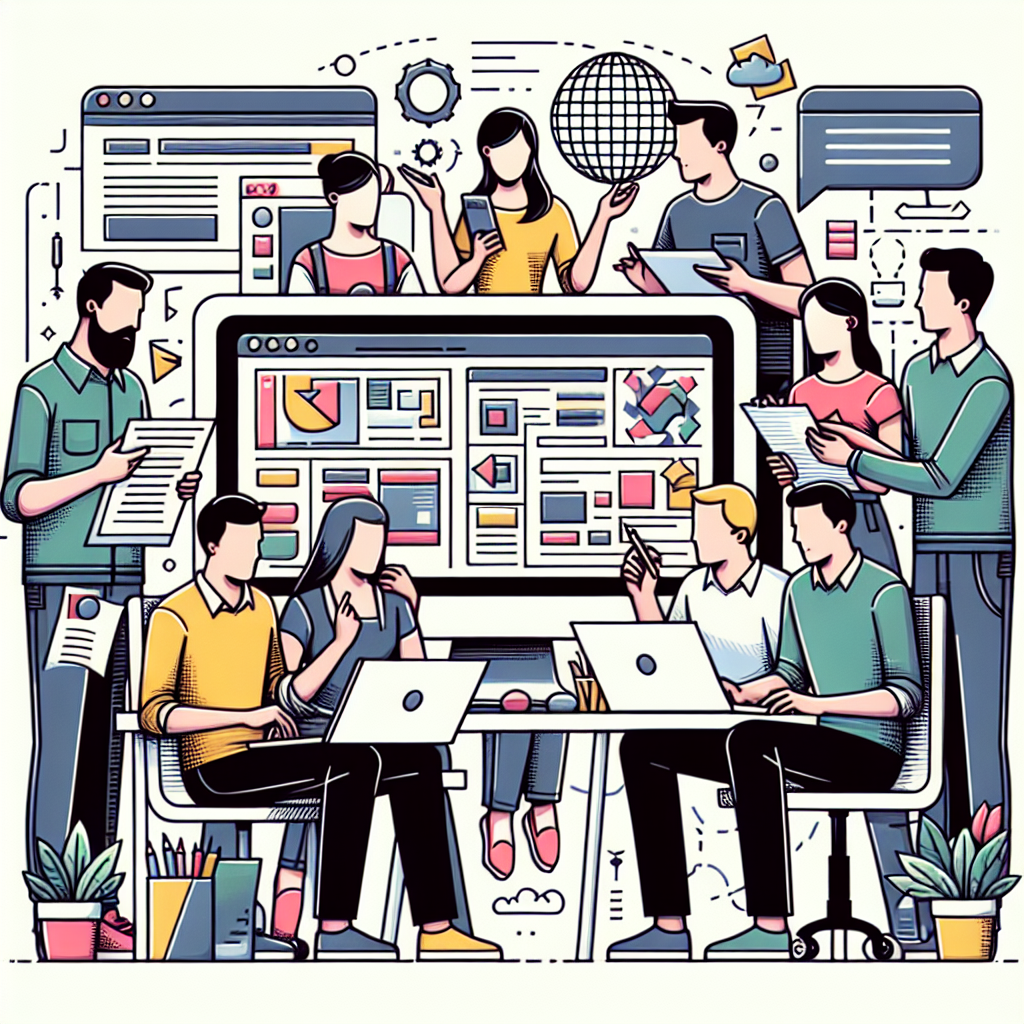Discover the Stages of Web Design and Development, Types of Web Design, and Key Rules for Creating Stunning Website Designs

What Are the Essential Stages of Website Design Development You Need to Know?

Website design is a journey that requires careful planning and execution. Knowing the stages of website design development can make a significant difference in the project’s success. But what exactly are these stages? Let’s break it down in a way that’s easy to understand, even if youre just starting out!
1. Goal Setting and Research ⭐
Every successful website starts with clear goals. What’s your website’s purpose? Are you looking to sell products, share information, or promote services? For example, a local bakery might want to create an online ordering system to reach more customers. This stage often involves:
- Identifying target audience
- Analyzing competitors
- Setting measurable objectives
Research shows that websites with well-defined goals see a 60% increase in user engagement. This is why establishing your objectives is crucial for effective stages of web design.
2. Planning and Structure ⭐️
Once you’ve set your goals, the next step is to plan the structure of your website. This includes creating a sitemap and wireframes. Imagine a roadmap guiding users through your content. For instance, if you are a consultant, your sitemap might include sections like Home, Services, About, and Contact. During this phase, you should think about:
- Navigation flow
- Content strategy
- Call-to-actions (CTAs)
A well-planned structure leads to a smoother user experience, helping to lower bounce rates by as much as 30%!
3. Design and Development ⭐
This is where the magic happens! The design phase entails creating the visual components of your website. This includes choosing colors, fonts, and images that resonate with brand identity. Let’s say you run an eco-friendly products store. Your design should incorporate earthy tones and natural imagery to reflect your values.
The development phase follows, where everything comes to life through coding. Whether youre using types of web design like responsive design to ensure it looks great on all devices or optimizing for SEO, its critical to collaborate closely with developers who understand your vision.
| Design Element | Importance | Action Steps |
| Color Scheme | Brand Recognition | Choose 2-3 primary colors |
| Typography | Readability and Tone | Select font pairings |
| Images | Visual Engagement | Use high-quality images |
| CTAs | User Engagement | Strategically place CTAs |
| Mobile Optimization | Accessibility | Test on multiple devices |
| SEO Elements | Google Ranking | Implement keywords |
| Social Media Links | Broaden Reach | Include in footer or header |
| Analytics Setup | Performance Tracking | Configure Google Analytics |
| Brand Consistency | Build Trust | Align all design aspects |
| User Feedback | Continuous Improvement | Engage in UX testing |
4. Testing and Launch ⭐
Before launching, the website undergoes rigorous testing. This includes checking for bugs, ensuring links work, and verifying that the site is optimized for various browsers. A financial advisors website, for example, must load quickly to keep potential clients engaged. According to research, a 1-second delay in load time can lead to a 7% reduction in conversions!
When everything checks out, its time to launch! Announce it through your chosen marketing channels—emails, social media, or even a launch party.
5. Maintenance and Analysis ⭐
After your website goes live, the journey isn’t over. Regular maintenance is vital to ensure it runs smoothly. You’ll want to track its performance using analytics. For instance, by analyzing visitor behavior, a yoga studio can adjust their content strategy to highlight popular classes, therefore boosting attendance.
Regular updates can improve security and functionality, making it easier for clients to find information. Remember, an up-to-date website helps retain users and drives them to convert!
At Artivale, we specialize in every stage of the website design process. With 20 years of experience and professional specialists, we guarantee a comprehensive approach. Contact our customer relations manager, Alexandra, at [email protected] or visit us at artivale.com for tailored solutions that best fit your needs! ⭐
Frequently Asked Questions ⭐
- What is the first stage of website design? Goal setting and research are the crucial first steps.
- How long does the website design process take? It usually varies based on complexity, but on average, it can take 4-12 weeks.
- What type of developers do I need? Youll need frontend developers for the user interface and backend developers for server-side functionality.
- Can I modify my website after launch? Absolutely! Frequent updates and optimizations are part of the maintenance.
- Is SEO included in website design? Yes, effective SEO practices should be integrated throughout the design stages.
- What do I do if I encounter bugs post-launch? Contact your development team for immediate support and resolution.
- How can I track website performance? Use analytic tools like Google Analytics to monitor user behavior.
- Do I need a mobile-friendly site? Yes, it’s essential for reaching a broader audience and improving user experience.
- What happens during the testing phase? It involves bug checking, cross-browser verification, and performance analysis.
- Why choose Artivale for web design? We offer a complete spectrum of services under one roof, ensuring smooth communication and exceptional results.
Unveiling the Myths: Stages of Web Design—What Most Articles About Web Design Get Wrong

The world of web design is filled with misconceptions that can mislead those looking to create an attractive and functional site. It’s easy to get swept up in the jargon and current trends, but understanding the truth behind these myths is essential for anyone embarking on a web design journey. Let’s dispel some of the most common myths about the stages of web design.
1. Myth: Web Design Is Just About Aesthetics ⭐
Many believe that web design and development only focuses on visual appeal. While aesthetics are undeniably important, they are just one piece of the puzzle. A beautiful website is meaningless if it offers poor user experience or lacks functionality. For example, an online clothing store may have stunning visuals, but if the checkout process is complicated, customers will abandon their carts. Web design encompasses:
- User experience (UX) – making the site intuitive and user-friendly
- Responsive design – ensuring the website works on all devices
- SEO – optimizing for search engines to increase visibility
2. Myth: One Size Fits All for Web Design ⭐️
Many articles about web design suggest that a single template can work for every type of business. The reality is that different industries have unique requirements. For instance, a portfolio site for an artist will need to showcase visuals prominently, while a corporate site might prioritize information accessibility. Customization is key to ensuring the website meets the specific needs of its audience.
3. Myth: You Only Need to Design Once ⭐
Some might think that once a website is designed, it should be set and forget. However, this couldnt be further from the truth. The digital landscape is constantly evolving, and so should your website. Regular updates and redesigns are necessary to keep the content relevant and secure. Maintenance should also include:
- Content updates – to reflect changing products or services
- Technical improvements – adapting to new technologies
- Regular security checks – addressing vulnerabilities
4. Myth: Web Design Is Cheap and Quick ⭐
This myth can lead to outsourcing projects to the lowest bidder, resulting in subpar outcomes. Quality web design requires time, effort, and expertise. A properly executed website can take several weeks or even months to develop. Investing in a professional service, like Artivale, ensures you get a reliable product. Research indicates that investing in quality design can lead to a 200% increase in conversion rates!
5. Myth: Coding Skills Are Essential for Web Design ⭐⭐
Though technical skills can enhance your capabilities, they are not strictly necessary for effective website creation. Many platforms now allow individuals with little to no coding experience to build stunning websites through user-friendly interfaces and templates. For example, services like WordPress provide templates that can be customized easily by anyone. This democratization of web design opens doors for many!
6. Myth: SEO Is Not Part of Web Design ⭐
Some might argue that web design and SEO (Search Engine Optimization) are two separate entities. In reality, they go hand in hand. A well-designed website will incorporate SEO best practices right from the start. This includes optimizing page titles, using descriptive URLs, and ensuring fast loading speeds. Without incorporating these elements, your website may struggle to rank in search results.
At Artivale, we are committed to breaking these myths and providing a comprehensive service that covers every stage of web design development. With our 20 years of experience, we guide you through the process—from initial goal setting to ongoing maintenance. Contact our customer relations manager, Alexandra, at [email protected] or visit artivale.com today to get started on a sustainable web design journey!
Frequently Asked Questions Regarding Web Design Myths ⭐
- Is web design only about how a site looks? No, it also involves usability, functionality, and SEO.
- Can I use the same template for different industries? It’s better to customize templates to fit specific needs.
- Do I need to redesign my site often? Yes, for updates and to keep up with trends; regular maintenance is crucial.
- Is cheap web design worth it? Investing in quality design typically leads to better results.
- Do I need coding skills to create a website? No, many platforms allow for easy design without coding.
- Must I consider SEO in my design? Absolutely! SEO is integral to web design.
- How can bad web design affect my business? Poor design can lead to high bounce rates and lost revenue.
- Are mobile and desktop design the same? No, responsive design adapts to different screen sizes.
- How does user experience impact web design success? A positive UX can significantly increase engagement and conversions.
- Who should I consult for professional web design? Reach out to experienced agencies like Artivale for guidance!
How Understanding Different Types of Web Design Can Transform Your Website and Boost Engagement

When it comes to creating a successful online presence, understanding the various types of web design is crucial. Each type serves a unique purpose and can significantly impact user engagement. Knowing which type to implement can be the key to attracting and retaining visitors, ultimately leading to higher conversions. Let’s explore how different web design styles can transform your website! ⭐
1. Static Web Design: The Simple Solution ⭐️
Static web design refers to websites with fixed content. Each page is coded in HTML and displays the same information to every visitor. This type is ideal for small businesses or personal sites that don’t require frequent updates. A local restaurant may choose a static site to showcase their menu and opening hours. While these sites are easy to create and host, they typically offer limited interactivity.
- Pros: Cost-effective, quick to develop
- Cons: Not easily updateable, less interactive
2. Dynamic Web Design: Engaging and Interactive ⭐
Dynamic websites are more flexible and can change content based on user interaction. Using a combination of server-side and client-side programming, these sites deliver personalized experiences. For example, an online clothing store uses dynamic design to show visitors tailored recommendations based on their browsing history. An engaging, interactive experience can enhance user satisfaction and loyalty, making this type invaluable for e-commerce and service-oriented websites.
- Pros: User-specific content, better engagement
- Cons: More complex to develop and maintain
3. Responsive Web Design: Adapting to Any Device ⭐
In the mobile-centric world we live in, responsive design is essential. This approach ensures your website adapts seamlessly to various screen sizes, whether on a smartphone, tablet, or computer. For instance, a travel agency might highlight beautiful photos and clear navigation across devices. Studies show that 57% of users won’t recommend a business with a poorly designed mobile site. A responsive design can significantly boost user retention!
- Pros: Improved user experience, better SEO ranking
- Cons: Can require more upfront investment
4. E-commerce Web Design: Selling Made Easy ⭐
E-commerce web design focuses on marketing products and driving sales. It incorporates user-friendly navigation, compelling CTAs, and secure payment gateways. Think of an online store like Amazon, where everything is designed to maximize conversions and enhance user experience. According to research, well-designed e-commerce sites see an increase in conversion rates by up to 400%! Every feature should facilitate a seamless shopping experience.
- Pros: Optimized for sales, user-centric design
- Cons: Requires continuous updates and monitoring
5. Portfolio Web Design: Eye-Catching Showcase ⭐
For creatives like photographers, artists, or writers, a stunning portfolio website is a must. This design style emphasizes visual content to showcase their work beautifully. A freelance graphic designer, for example, might use bold images and creative layouts to draw potential clients in. High-quality visuals and easy navigation can lead to increased inquiries and a growing clientele. It’s all about making a great first impression!
- Pros: Visually appealing, effectively showcases talent
- Cons: May require regular content updates
6. Blog/Web Content Design: Engaging Readers ⭐
Blogs are essential for businesses aiming to provide value and establish authority. Effective blog design focuses on readability, engagement, and navigation. For instance, a cooking blog might highlight recipes with clear images and step-by-step instructions. High engagement gets higher rankings on search engines. Engaging content combined with excellent design can significantly improve audience retention.
- Pros: Builds community, fosters loyalty
- Cons: Requires regular content updates
Transforming Your Website with the Right Design Type ✨
By understanding the different stages of website design and the various types available, you can make informed decisions that cater to your audience’s needs. Each design approach offers unique benefits and can be tailored to enhance user experience. At Artivale, we guide you through every step of the process, ensuring you choose the right design for your specific goals.
If you want to elevate your web presence and increase engagement, get in touch with our customer relations manager, Alexandra, at [email protected]. Visit artivale.com today! ⭐
Frequently Asked Questions About Web Design Types ⭐
- What is static web design? Its a type where pages show the same content to all visitors.
- What are the benefits of dynamic web design? It offers personalized content and improves user engagement.
- Why is responsive design important? It ensures compatibility across multiple devices for a seamless user experience.
- What defines e-commerce web design? It focuses on facilitating online shopping through user-friendly interfaces.
- How does portfolio web design work? It effectively showcases creative work using appealing visuals and layouts.
- Why choose blog design for a business? It helps build authority and fosters a loyal audience.
- Can I combine different design types? Yes, a hybrid approach can often work to meet diverse goals.
- How often should I update my website design? Its best to refresh your design every few years to keep up with trends and technology.
- Is web design just for appearance? No, functionality and user experience are equally important.
- How can Artivale help me with my website? We offer comprehensive services from initial planning to ongoing maintenance!
Submit your details in the form and our team will personally get in touch with you within the next business day to discuss your needs
